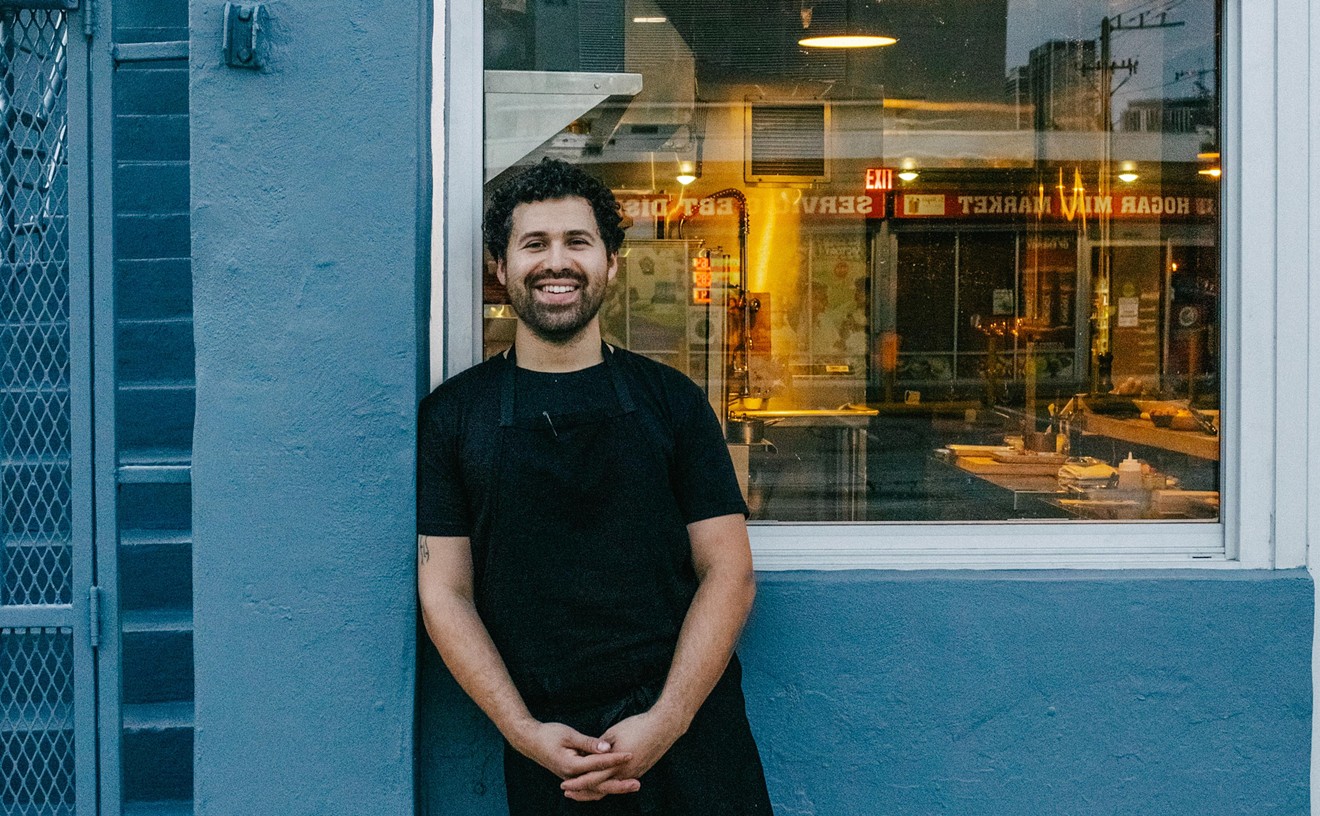Why? You could say it was because of the “Max” so prominently featured in the bistro's appellation. That's Dennis Max, the archetypal restaurateur who, with the help of his many partners, chefs, and hired hands, neon-ed a name for himself and South Florida back in the Miami Vice era. Any eatery that opens with the Max marquee, someone is bound to tell you, will be an instant taste-bud success.
But there's much more to this tale, which includes famous gastronomic characters and a number of South Florida's most famous restaurants. It is, in part, the story of the founding of the region's modern culinary scene. In fact the scene wasn't just born; it was made, in the manner of a Greek comedy -- or tragedy, depending on your point of view. And the extremely influential individuals who created it still play a major role, chasing one another around in what some would label a vicious circle: All of them, in a six-degrees-of-separation kind of way, worked together. But along the way, partners have sued, cheated, and even begun divorce proceedings against one another. Almost all have committed the eternal crime of backstabbing (which hurts even more when done with kitchen knives). Many no longer are on speaking terms -- though given the narrow confines of our subtropical world they can't seem to avoid one another, either -- while others have reconciled and moved forward.
It began back in the mid-Eighties, when Dennis Max and his wife, Patti, founded Café Max in Pompano Beach, the flagship restaurant of what eventually would be an exclusive culinary domain. The Max duo quickly formed an alliance with partner Mary Anne Richter, who wanted to help run the first-ever California-style eatery in South Florida. Soon the trio brought a then-unknown Mark Militello onboard as executive chef, and almost immediately began receiving attention from a nation sick of nouvelle cuisine. The fare was the precursor to New World cuisine, emphasizing clean flavors, inventive combinations, and the use of local products. It had its base in the California movement, where foods were being grilled over mesquite and served with light sauces and reductions. Over time Caribbean influences emerged, and terms like Floribbean, Florida fusion, and New World were applied.
The quartet went on to open Max's Place in North Miami, which focused on New American cuisine, and Maxaluna, serving California-influenced northern Italian fare, in Boca Raton. Both restaurants became equally as popular as Café Max.
Despite the positive attention from diners and critics alike, however, the partnership was troubled. Dennis Max wanted to create more Max eateries, while Militello wanted to downsize and concentrate on cuisine. The ensuing split was so rancorous that Max and Militello, according to sources, signed lawyer-penned statements stating that they wouldn't talk to the press about each other. (Indeed Militello refused to comment on this story, saying only that New Times should be careful, because his latest partner is a lawyer.) The upshot was that Militello would buy out Max's interest in Max's Place and Max would retain Maxaluna. Café Max was sold to third parties Oliver Saucy and Darrel Broek for a reportedly enormously inflated price.
Left in the middle, Richter chose to align herself with Militello and became his partner in Max's Place, which quickly was renamed Mark's Place. While Max and wife Patti, with the help of partners Burt Rapoport and developer Dan Catafulmo, launched a string of brasseries, bistros, and grills in Broward and Palm Beach counties, Militello and Richter focused on turning Mark's Place into a gastronomic landmark. They thrived and decided to expand into Fort Lauderdale, opening Mark's Las Olas, another immediate success. And then, not having quite learned their lesson the first time around, they overextended themselves and inaugurated a third eatery, Mark's at Grove Isle, which was troubled from the very beginning. Eventually the strain of operating three fine-dining establishments took its toll, and the pair divested Grove Isle and disposed of Militello's personal flagship, Mark's Place. Then they quit each other. Militello ran Mark's Las Olas (later to reopen in Miami) and Richter, lo these many years later, has reteamed with ... Dennis Max. Thus the new Max's Place, this time more of a café than a fine-dining restaurant, is kind of the old Max's, reborn in Bal Harbour.
Here then is the story of the rises and falls and returns of Max, Militello, and Richter, in all their combinations.
Act One really begins three decades ago, in Los Angeles circa 1972, when West Coaster Dennis Max met East Coaster Burt Rapoport. Both were assistant managers in one of the nation's first non-fast food chain restaurants, Victoria Station. They were both on the fast track to becoming regional managers, and they both had the ambition to work for themselves. A year later Max was transferred and Rapoport was assigned to the Northeast, but the two never lost touch, actually forming a marketing consulting company together. Eventually Dave Alderman, the head of their first client, Chuck's Steakhouse Restaurants, asked the pair if they'd be interested in climbing onboard a new venture in Fort Lauderdale. The two performed the proverbial jump at the chance and relocated to South Florida.
Fast-forward to Fort Lauderdale, 1977 (can anyone say culinary wasteland?). But the concept seemed like a good one -- a Mexican eatery called Carlos and Pepe's. Right before the place opened, however, Max and Rapoport had a falling-out with Alderman. “We had philosophical differences,” says Rapoport, “and left a month before the opening.” Max says they split right after the opening. Still, the results were the same: Max and Rapoport sold their stock back to Alderman for $3750 each, maybe a misstep. According to Rapoport in the first year of operation, Carlos and Pepe's grossed a million bucks in pure profit.
Regardless of hindsight the pair was “stuck in South Florida,” as Max puts it, without a restaurant. And little did they know the phrase philosophical differences would become a mainstay in their vocabulary, and that disintegrating partnerships would be par for the course. But they were still interested in launching a place together, and their particular merger seemed to be destined. Rapoport was from a restaurateuring family in Manhattan; Max had a financial background, having graduated with an MBA and worked as a Wall Street broker for four years. So they continued to search for a location, and found one through Dan Duckham, an architect.
Duckham already had a group of five investors searching for a restaurant. Duckham talked Max and Rapoport into joining forces, and the gang of eight opened Raffles in the Dadeland Mall in 1979. The restaurant, which Max calls a “fern bar” à la the kind people hung out in on the West Coast, “had a T.G.I. Friday's kind of theme,” he concedes. “We had fresh food, were real approachable, and featured live jazz from University of Miami [students].” Rapoport concurs: “We were Friday's and Houlihan's with better food. Lots of energy, a great look, and the guys from Miami Sound Machine used to play there.”
Indeed Raffles was such a cash cow the group decided to replicate. By 1982 Max and Rapoport had formed a restaurant company called Creative Restaurants, Inc. Max was president, Rapoport was vice president, and the pair oversaw seven Raffles restaurants in Fort Myers, Orlando, and Atlanta, Georgia. They planned on opening another half-dozen or so. But in 1983 Max and Rapoport had grown tired of the concept.
“By then we had replaced the group with a single partner,” Rapoport explains. “But we were cavalier about success. We thought we couldn't do wrong. We felt invincible. Plus we were partying like crazy -- it was the early Eighties in Miami, after all. So Dennis and I sold all the [Raffles] locations to our partner and left.”
This time they also “went in different directions,” Rapoport says. Take that literally. Rapoport moved to Long Island, where he opened Summerfield's in 1985. The restaurant, which served designer pizzas, pastas, and anything that could be cooked on a mesquite grill, would later become a prototype for the Prezzo chain he would launch with Max upon his return to South Florida in 1988.
As for Max, he had recently married his third wife, Patti, who had majored in fashion and design at the University of Miami. Max and his wife began looking for a restaurant location. “We wanted to do a neighborhood kind of place where we were involved in every detail,” notes Max, by then a veteran of two chains. “We found an old 1930s drugstore in Pompano Beach. And that was Café Max.”
It also was far from a neighborhood kind of place. In fact it was the start of a new kind of restaurant chain: the so-called restaurant group. Wrote Lucy Cooper in the Miami Herald in 1982: “[Their] success is due, in part, to recognizing and capitalizing on a concept whose time had come. Their future may depend on a timely recognition of the winds of change.”
Next week, Act Two, The Rise and Rise of Max and Max : How Dennis and Patti form a nationally admired empire and inspire a local diaspora, surviving the bitter breakup with partner and name-making chef Mark Militello after the launch of their third restaurant. But at what cost? Also, the rise and demise of Militello and Mary Anne Richter: Partners for more than a decade, the pair falls victim again to the Curse of Three. Now they no longer communicate, squabbling over the loyalties of friends and business personnel alike.









